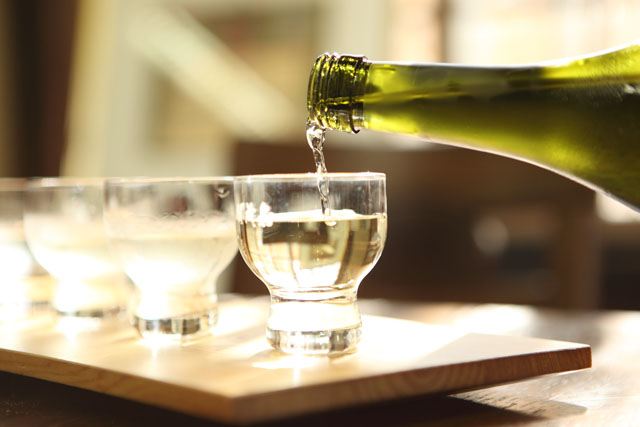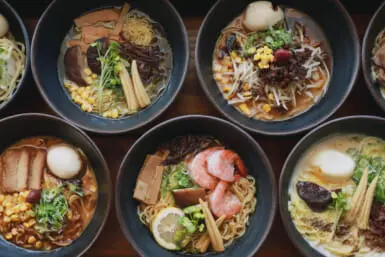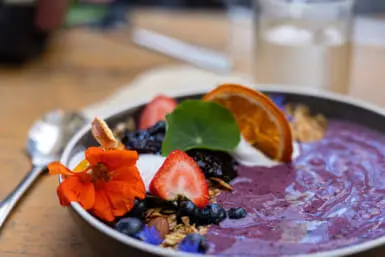The second part of our look into the world of sake begins not at the table, but in the lab.
By Sami Kawahara
To begin to understand how sake is produced, we can loosely compare it to wine and beer. Sake is similar to wine in that different rice and different grapes yield different varieties. However, beyond the types of rice, the amount of “polishing” of the rice generally determines the quality and variety of sake. Polishing, or stripping the rice of unwanted oils and lipids in the outer layers, is the first step in the production process (see sidebar on the previous page for varieties and percent of polishing). After polishing, the rice is washed, soaked, and steamed, with each step carefully timed as only a matter of seconds can change the overall result.
After the rice is cooled, the fermentation process begins. We can now compare sake to beer because both are unlike wine, where sugar is naturally found in the grape, ready to be fermented into alcohol. Sake and beer are made from rice and wheat with no natural sugars, making it necessary to first convert its starch into sugar before being able to ferment into alcohol. Here, sake differs from beer because the two conversions – starch to sugar, then sugar to alcohol – happen simultaneously with sake and in two steps with beer.
Sake fermentation begins with a mold called koji-kin. This mold releases enzymes to facilitate the starch-to-sugar conversion. The koji mold powder is sprinkled over the steamed rice and checked over the next few days until each grain is covered in mold. This mixture of mold and rice is called koji.
After the koji is made, the yeast starter, known as moto, is created by mixing the finished koji, additional steamed rice, water, and yeast. Over the next two weeks, the yeast is multiplied and ready to take to the big fermentation and brewing tank. In the fermentation area, large metal tanks fill up rows of space in the humid room. In these tanks, more rice, koji and water are added three different times over four days to make sure the yeast can keep up with all of the additions. After the final addition, the “mash” is left to ferment for around 30 days.
Once fermentation is complete, sake is extracted from the solid mixture by filtration. Depending on the variety, sake is handled differently from pressing to bottling. Sake can be pasteurized, unpasteurized (namazake, or ‘fresh’ sake), aged (koshu), roughly filtered (nigori), undiluted (genshu), ordinary (futsushu), sparkling, and more.
Time to drink
And now, with this newfound knowledge of the different types of sake and how it is produced, how do I drink it and what do I pair it with?
Having met some International Wine Challenge sake chairmen on the brewery tour, along with a production team from the Discovery Channel, I decided to contact local and foreign experts of sake to gather further assessments. John Gauntner, the only non-Japanese Master of Sake in the world, gave a few guiding principles for the novice sake drinker.
“Sake has a place at the table. It is not this novelty: it is a player and an incredibly valuable tool in the arsenal of food pairing”
However, one underlying theme in his advice was that there is no real consensus. Whether it’s pairing food, etiquette when tasting, or how varieties are split up, he says that everyone might give a different answer based on personal experience. Rather than rules, then, Gauntner offers more general fundamentals.
With all the different varieties out there, it can be hard to keep track of which sake is more premium than the next. But it is easy to remember: “If you drink something with the word ginjo on the bottle, or ginjo is somewhere embedded in the word, you are drinking the top 10% of sake out there,” Gauntner notes. “And most of the time you’re going to want to drink your premium sake slightly chilled.”
With sake’s rich tradition, I imagined only drinking sake in a wooden, “masu” box while being intimidated by all the etiquette and culture that comes along with it. But I learned that sake is actually better tasted in stemware. Instead of sipping in a small, porcelain cup as we most commonly see, sipping from a wine glass, helping us see clarity and take in the aroma, enhances the whole tasting experience. You may even be able to feel that “touch of yogurt on the nose” or the “rich, cheesy, round, earthy” style that many of the IWC judges noted in the competition.
Gauntner explains that mismatches are rare when pairing sake with food. Sake sommelier Beau Timkens adds, “Anything coming from the ocean, I would match with a starch-based sake over a ‘grape juice’ (wine) any day.” He points out that “sake has a place at the table. It is not this novelty: it is a player and an incredibly valuable tool in the arsenal of food pairing.”
Timkens emphasizes that there are endless ways to pair sake with food but it simply comes down to making the decision to make your way into the sake world. Both Timkens and Gauntner agree that “people just need to go out and try it.”
Feeling enlightened, I realized that exploring the roots of Japan’s sake industry and the drink’s boundless forms is something everyone should try. So, “take that bottle of sake home, bring it with you to the BBQ, or to that Italian restaurant,” Timkens says. “I dare you.”
Beau Timken’s General Rules for Pairing
As a strong believer in pairing sake with Japanese food as well as Western food, Timkens gives us his general rules for matching food with sake. He begins with the daiginjo category.
Rice is polished to at least 50% and the resulting drink is generally light, complex and quite fragrant, making it traditionally go well with very light appetizers. Next, the ginjo’s light, clean presence pulls out flavors and pairs well with lightly prepared meals. The junmai category is for the center of the plate. It has more structure, and is similar to red wine. A big, fruity nama genshu (unpasteurized sake) goes well with international spices, for example Thai or Indian cuisine. Nigori, an unfiltered, cloudy sake, is also great for bigger international cuisine or can be used as a substitute for dessert wine. Hanjozo, sake with a small addition of distilled alcohol, is perfect for anything coming off the grill. Koshu (aged sake) pairs well with big game such as wild boar, duck, pheasant or goose. Sparkling sake compliments a cheese board, and Timkens concludes by stating that the more complex the cuisine, the higher the acidity.
Starters & Appetizers
The light and fragrant tones of a Daiginjo compliment light starter dishes and appetizers like seafood salad or maybe some calamari.
Mains
Koshu is the perfect accompaniment for a full-bodied main cause such as duck or pheasant. This aged sake pairs well with the strong flavors of game.
Dessert
Nigori is generally the sweetest of all sakes, with a fruity nose and a mild flavor. It’s a great drink to complement a dessert like chocolate torte.









